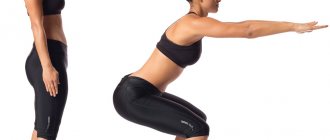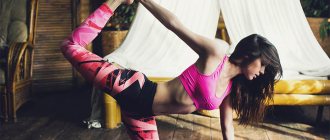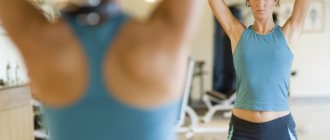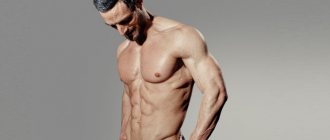Regular squats
Starting position: standing, feet approximately shoulder-width apart, arms with dumbbells lowered along the body.
Do some deep squats. Keep your back straight. Make sure that at the lowest point your knees do not go out to the sides, but are above your toes.
Exercises
Now that you know how to choose the right loads, and that you will have to train hard, you can begin to consider the most effective solutions for pumping up the buttocks. The list of exercises is quite large, but this does not mean that all of them need to be performed in one day:
- dumbbell plie;
- squats with wide legs;
- deep squats;
- lunges;
- farmer's walk with long strides;
- deadlift (bending forward with dumbbells).
Let's look at how it works and how to do each of them correctly.
There is another exercise - this is the gluteal bridge. This is an extremely difficult exercise that requires a barbell or Smith bench. At the same time, its effectiveness is extremely low, and the slightest violation of the technique can have a very bad effect on the overall health.
Dumbbell plie
The dumbbell plie is the first basic dumbbell exercise for the buttocks and thighs. It almost completely disables the quadriceps from working. In this case, the entire emphasis shifts exclusively to the gluteal muscles. If your goal is exceptionally beautiful legs, thighs and firm buttocks, you won’t be able to do without it.
How to do it?
- Spread your legs as wide as possible.
- Socks point to the sides.
- Bend your back.
- The head looks straight ahead. If this is difficult, you can look up, but not down.
- Dumbbell – weighing up to 15 kg (for beginners, the optimal weight is 5-8 kg), located in the hands, between the legs.
- Squat down as deeply as possible, while maintaining an arch in your back.
- Fix at the lowest point for 1-2 seconds.
- Get up.
If you have a mirror, looking into it you should see movements very similar to how sumo wrestlers take the starting position before a match.
Wide Leg Squats
This exercise with dumbbells for the buttocks is more suitable for losing weight than for pumping up muscles. Despite its anaerobic nature, it involves all major muscle groups, due to which calorie content and energy consumption during the approach increase several times. All this leads to a calorie deficit and weight loss. From the point of view of using the buttocks, here, depending on the placement of the heels, the load may shift slightly to the front of the legs, which will allow them to be tightened, but in general the load falls on the back of the legs.
How to do it correctly?
- For squats with deep legs, you will need 2 heavy dumbbells (weighing 5 kg or more).
Then there are two techniques. With dumbbells placed on your shoulders (like weight lifters), or the ability to place them crosswise on your chest (Coleman technique).
- Dumbbells are placed in their starting position.
- Legs are placed 1 foot wider than shoulder width on each side
- Bend your back.
- The head looks straight ahead. If this is difficult, you can look up, but not down.
- Squat down as deeply as possible, while maintaining an arch in your back.
- Fix at the lowest point for 1-2 seconds.
- Get up.
The technique is very similar to plie, but, unlike the previous exercise with dumbbells for the buttocks and legs, this is somewhat more difficult to perform. In addition, the load is much stronger. The main difference and emphasis in the work occurs solely due to changes in the placement of the legs.
Deep squats
This exercise came into home workouts from classical physical education. At the same time, many underestimate its power, or simply do it incorrectly.
So, let's look at the technique:
- The dumbbells are placed in the starting position, similar to the previous exercise.
- Feet become shoulder-width apart.
- There is a strong arch in the back.
- Head straight ahead.
- Next you need to start moving your hips back. That is, do not bend your knees, but tilt your body back and make a maximum descent, simultaneously bending your legs.
- Fix at the lowest point for 1-2 seconds.
- Get up.
To emphasize the load, you can place small wooden planks up to 10 centimeters thick under the socks. To remove emphasis, these same boards can be placed under the heels.
It is due to this movement that the load falls entirely on the gluteal muscles, bypassing the quadriceps. If you need to change the load on the contrary, remove the tilt of the body back and keep your back completely straight
Lunges
The next exercise seems extremely simple, until you start doing it. Yes, yes, these are lunges with dumbbells, which, unlike the previous ones, are an isolating exercise. What does it mean? That's right, that exclusively the gluteal muscles and the back of the thigh are involved. The quadriceps, calves and back muscles serve exclusively as stabilizers.
How to do it correctly?
- Dumbbells are placed on the shoulders.
- One leg is placed as wide forward as possible.
- Next, bend your back
- Stretch towards your leg (make maximum emphasis).
- Make 2-3 springing movements.
- Change leg.
In total, this should be done 7-12 circles on each leg. The optimal weight for beginners is 5-8 kg each dumbbell.
Farmer's Walk with Long Steps
The farmer's walk with a wide stride is a more dynamic technique of the previous exercise. The main difference starts from the 5th point of movement. Namely, instead of just changing legs. From the lunge position, you need to move your back leg forward and lunge onto it. To visualize this movement easier, imagine that you are simply walking very wide, carrying bags of food in your hands. Although the position of the dumbbells plays an important role, since much larger equipment is used in the walk, the main recommendation would be to change their position. Those. can be held as during Plie.
Deadlift (forward bends with dumbbells)
This exercise is actively used in powerlifting, and even experienced athletes cannot always perform it correctly. But at the same time, of all of the above, it puts the greatest load on the back of the thigh, back muscles (responsible for posture), and most importantly, on the gluteal muscles.
How to perform a deadlift correctly?
- Dumbbells are picked up.
- Feet are placed shoulder width apart.
- The arch in the back remains
- The head looks ahead.
- Start moving downwards, keeping your back arched and your legs as straight as possible.
- At the lowest point, try to touch the floor (if stretching allows).
- Carefully rise from the lower phase, maintaining the deflection.
Power Row with Back Lunge
Starting position: standing on one leg, one hand on your waist, the other down.
Bend your body forward while balancing on one leg. Then bring your knee forward, and then lunge back with the same leg. Quite a complex exercise that requires good coordination of movements.
Classic squats for the buttocks with dumbbells - how to do them correctly?
- the pelvis falls as low as possible to a line parallel to the floor;
- toes always point to the sides (at an angle of approximately 45 degrees);
- weight is distributed along the outside of the foot and on the heels;
- the back gently bends forward (for this, the gaze is kept at a height - for example, the far corner of the ceiling);
- The knees of the legs at the top point do not extend during one approach, that is, the legs remain half-bent throughout the entire approach.
- dumbbells are held at chest level or along the legs with outstretched arms - whichever is more convenient.
Squats with dumbbells (arms extended forward)
Squats with dumbbells (hands at the chest)
The width of the legs is also selected individually; the narrower they are placed, the more the quadriceps of the thigh are involved. The number of repetitions and approaches, as well as the weight of the dumbbell, depends on the initial level of training of the athlete.
Watch the video for a detailed description of how to squat with dumbbells correctly.
Option #1 - Sumo squats with dumbbells and barbell
Sumo squats with dumbbells work the gluteus maximus and internal thigh adductors.
Sumo squats with dumbbells
Do not confuse sumo squats and plie squats; these are two completely different exercises. Plie squats are done with a straight back and knees apart, and when performing sumo, the legs are simply spread wider than with a regular squat and the buttocks are pulled back.
Watch the video for more details:
Light weight dumbbells are suitable for beginners.
In the first version of the “dumbbell sumo” exercise, you take a large dumbbell and hold it below. In this case, the emphasis is on the leg muscles and gluteal muscles.
Sumo squats with dumbbells below
Look at the video on what to pay attention to when performing the “sumo with dumbbells below” exercise:
The dumbbell below can be replaced with a kettlebell.
Sumo squats with kettlebell
In the second version of the exercise, we hold dumbbells at the chest. This option works the arm muscles more. You can take two lighter dumbbells.
Sumo squats with dumbbells at chest level
Or one heavier one.
Sumo squats with dumbbells at the chest
Option No. 2 - Plie squats with dumbbells
It is not without reason that plie squats are loved by a huge number of beginners and advanced athletes. This exercise perfectly works the inner thigh and gluteal muscles.
An interesting variation of the plie squat with a variation of the French press. In this case, we take two dumbbells and, when lifting, raise our hands up, and when lowering, we put our hands behind our heads.
Plie squats with a variation of the French press
Option number 3 - Squats on one leg with support on a chair
Squats on one leg supported on a chair are an excellent exercise for developing beautiful buttocks. We stand with one foot on the floor, and place the other on a chair behind us.
Place one foot on a chair
Let's do a squat. Keep your back straight.
Doing a squat with support on a chair
We do it alternately, first on one leg, then on the other leg. You can take dumbbells for weighting.
Squats on one leg with support on a chair
Option #4 - Squats with lunges for girls
Squats with lunges are the best exercise for beautiful buttocks and legs. To perform it, stand up straight.
Let's stand up straight
We step forward with one foot so that it stands at a right angle. The knee of the second leg points to the floor.
Doing a squat
The lunge exercise is a very effective exercise in itself. There are many varieties of its implementation. This exercise is simply ideal for creating beautiful buttocks.
Squats with lunges for girls
To perform the exercise you will need 2 dumbbells. We take one fairly broad step forward. We try to keep the front leg at an angle of 90 degrees (the knee is above the heel). We transfer the center of gravity to the heel and lower ourselves down. Then we go back.
It is very useful to “walk” with lunges from one wall to another.
Squats with lunges for girls
For a detailed description of the exercise, watch the video:
Sumo squats
Starting position: standing with legs wide, arms with dumbbells lowered in front of the body.
Perform several squats, keeping your back straight and keeping your knees inward. This exercise uses slightly different muscles than a regular squat, so it may seem quite difficult at first.
Workouts for pumping up your butt with a machine at home and in the gym: rules, mistakes, recommendations
To create the right buttock training program, you need to study their structure. They consist of the gluteus maximus, medius and minimus muscles. The first muscle is the largest, it is located on top of the other muscles, the second is located above, and the third below the large gluteal bundle. The largest muscle is involved in hip extension, the middle and small muscles are involved in abduction.
To effectively pump up your buttocks, you need to follow these rules:
- Train systematically. The best option is 2 to 3 times a week with a break of 1-2 days to restore muscles.
- Before training, you need to warm up the muscles with joint exercises, then follow a small block of cardio (jogging, jumping rope).
- In one workout you need to perform from 3 to 6 elements to develop the buttocks. Of these, from 2 to 4 are basic, and 1-3 are insulating.
- Repeat the movement 10-15 times.
- First, hone your technique by working with minimal weights. Gradually increase the weight of the shells.
- Set aside a separate day to work your gluteal muscles.
This is interesting! The large muscle works when the athlete performs climbs, lunges, and squats with a barbell. The middle and small bundles are loaded during swings, leg lifts, and stretching exercises.
To pump up rounded buttocks, you need to avoid common mistakes:
- Beginners spend too much time doing cardio, which causes their muscles to not receive the necessary stress.
- They train with too little weight and too many repetitions, making progress barely noticeable.
- During training, beginners use too heavy equipment, which is why technique suffers and the load is dissipated on other muscle groups.
- During training, athletes use equipment with the same weight and perform the same number of repetitions.
- Do not use peak muscle contraction. It is important to fixate at a high point when lowering the weight.
- Use only squats and deadlifts. To pump up your buttocks well, you need to use more exercises.
- They constantly work according to the same program. The complex needs to be changed and replenished with new elements once every 1.5 months.
Some beginners are too fanatical about their work, practicing every day. However, this threatens to exhaust the muscles and the entire body.
This is interesting! Protein shakes will help enhance the effect of building muscle mass.
Be sure to check out:
How to properly squat for a girl to pump up her buttocks: the best exercises 8 of the most effective exercises for the buttocks for girls at home and a 4-week pumping program Taking a course to Brazil: pumping up the buttocks and thighs Pumping up the legs at home: exercises for girls
Front Squats
Starting position: standing, legs located at a distance slightly greater than shoulder width, dumbbells in arms raised and bent at the elbows above the shoulders.
Perform several squats without lowering your elbows and trying to keep your body as straight as possible.
Mill
Starting position: standing, feet positioned perpendicular, one arm with a dumbbell extended upward above the head, the other lowered along the body.
Slowly bend to the side while holding the dumbbell overhead. Try to bend down as low as possible and then slowly return to the starting position.
Weighted bridge
Starting position: lying down, legs bent at the knees, feet resting on the floor, hands with dumbbells resting on the hips.
Lift your pelvis up so that your body rests only on your shoulders and feet. Pause a little at the top and then return to the starting position.
Training the buttocks at home (Option No. 1)
In this butt workout, you won't need any additional weights, as the exercises put maximum stress on the muscles, making them burn. Perform the exercises for the specified number of repetitions sequentially, one after the other, concentrating on each movement.
Squat with pulse at 1-2-3
Lower yourself into a classic squat, pushing your pelvis back and keeping your back straight. At the bottom point, make 3 pulsating movements with a small amplitude and rise to the starting position. Squat to parallel, start pulsating when you reach the bottom point, not earlier, otherwise the muscles will not receive full load.
How much to do: 10 repetitions.
Back lunges
From a standing position, take a long step back and lower into a lunge until parallel to the floor. Return to the starting position and repeat with the other leg. Do lunges with each leg in turn, making sure that your knees bend at a right angle and do not protrude beyond your toes. It is important to take steps exactly back, maintaining rhythm and balance.
How much to do: 10 reps on each side.
Wide squat + diagonal lunge
Do a wide squat, then rise up and from this position lunge back diagonally. Return to the starting position and squat, then rise and repeat the diagonal lunge with the same leg. When you complete all reps on one leg, switch sides and repeat the exercise.
How much to do: 10 reps on each side.
Side lunge
From a standing position, step to the side and lower into a side lunge, bending your knee and moving your pelvis back. At the end point, the thigh should be parallel to the floor, but beginners can perform the lunge with a small amplitude. The other leg remains motionless and straight. With an energetic movement, return to the starting position and repeat the side lunge on the same leg. After completing all repetitions, do the same with the other leg.
How much to do: 10 repetitions, first on one side, then on the other.
Walking on 1-2-3
Lower yourself into a classic squat and from this position take three steps to the side, then repeat the step in the other direction without rising from the squat. During the exercise, make sure that your thighs and buttocks are tense and your back remains straight. If it is difficult to perform a 1-2-3 pass in both directions, then after the first count, rise to the starting position and only then repeat in the other direction.
How much to do: 5 “walks” there and back.
Rising from a chair
Sit on a chair, raise one leg, keep your hands near your chest. Rise from the chair without helping yourself with your hands, while your leg should remain suspended. Shift your body weight to your supporting leg and lift using the muscles of your buttocks and thighs. Do all sets on one leg and then repeat on the other.
How much to do: 10 repetitions, first on one side, then on the other.
Narrow squat + side step
Place your feet together and squat until parallel to the floor. Then take a step back to the left with your left foot, turning your body and without straightening your knees. While remaining in the squat, return with the same step back to the starting position. Do all repetitions on one leg, and then perform the exercise with your right leg to the right side.
How much to do: 10 repetitions, first on one side, then on the other.
Swing your leg up
Get on all fours, back straight, knees bent at right angles. Lift one leg up without straightening your knee. Perform the swing until the thigh is parallel to the floor; in this position, the muscles of the back of the legs and buttocks are well loaded. Don't forget to do the same for the other leg.
How much to do: 15 repetitions, first on one side, then on the other.
Leg swing up pulsating
From a position on all fours, lift your leg bent at the knee up, as for classic swings. When the thigh is parallel to the floor, pulse in an even rhythm with a small amplitude, feeling the work of the buttocks. Repeat with the other leg. This exercise for the buttocks is responsible for their pumping, which means for a beautiful, rounded shape and elasticity.
How much to do: 20 “pulses” first on one side, then on the other.
Gluteal bridge
Lie on your back, bend your knees, place your feet on your heels for greater load on the gluteal muscles. Raise your pelvis, tensing your buttock muscles and keeping your feet on the floor. Rise to a level line between your hips and body, then lower all the way down until your buttocks touch the floor and rise again. Perform this effective glute exercise rhythmically, but not too quickly, to maintain tension in the muscles.
How much to do: 15 repetitions.
Bridge with leg spread
Lie on your back, bend your knees and place your feet together. From this position, perform a classic glute bridge, lifting your pelvis up so that your torso is in line with your hips. At the top point, spread and bring your knees together, straining your buttocks. Try not to sag in your back, otherwise the glute exercise will not be as effective.
How much to do: 15 repetitions.
Bridge with raised leg
Lie on your back and bend your knees. Straighten one leg and lift your pelvis up, making a bridge. Keep your leg suspended, lifting it as high as possible, while lifting your pelvis, as in a classic bridge. After completing all the reps on one leg, do the same on the other. Incorporate this exercise into your glute workout to get those muscles burning.
How much to do: 10 repetitions, first on one side, then on the other.
Bridge with leg swings
Lying on your back, bend your knees. Lift your pelvis up, as in a regular bridge, and fix the position. Straighten your knees alternately, moving rhythmically and trying not to sag in your back. During this exercise for the buttocks, the muscles are constantly under tension, which is what makes it so effective.
How much to do: 10 reps on each side.











